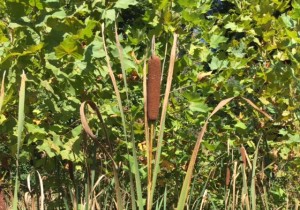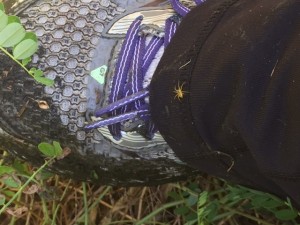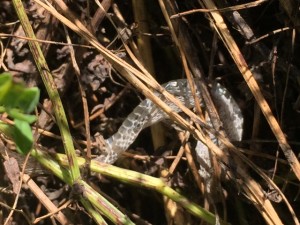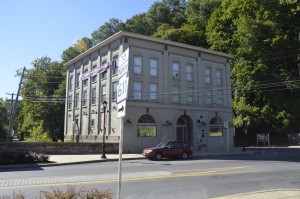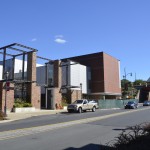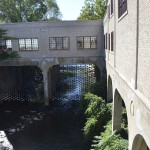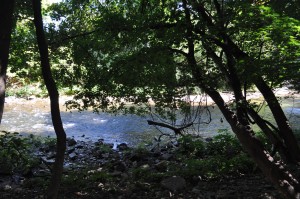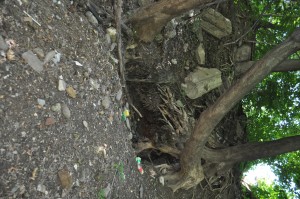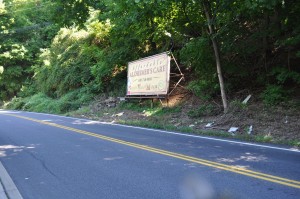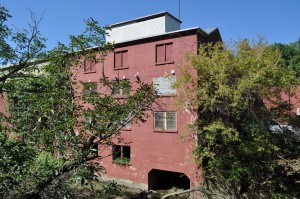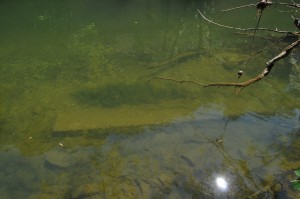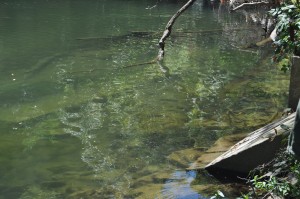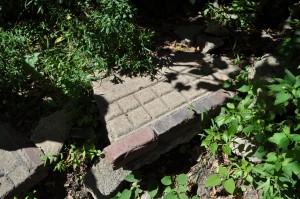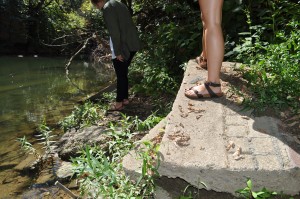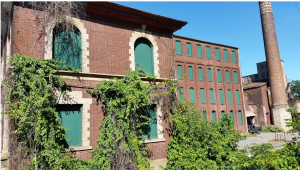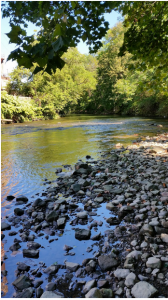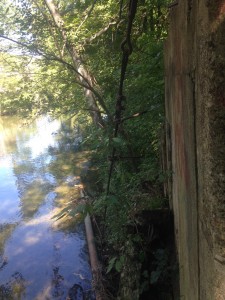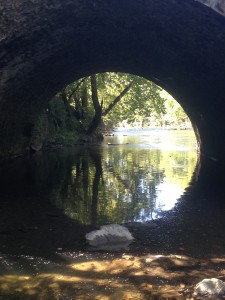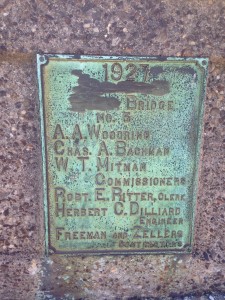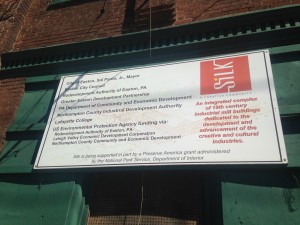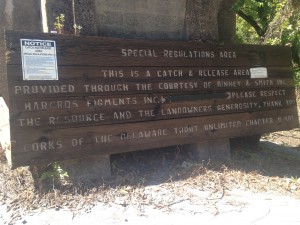During our alone time in Sullivan Park today I realized I seem to experience nature in a childlike way. I would see, hear, smell, or touch something and my thoughts revolved around “ooh”, “ahh”, “what”, “why”, and “how”. I was so curious about this and that, jumping from thing to thing like a five year old in a candy store. In fact after the experience I kept thinking about how I was pretty much just playing a game of I-Spy with the things around me. So I thought I might share a few of my I-Spy finds with you all:
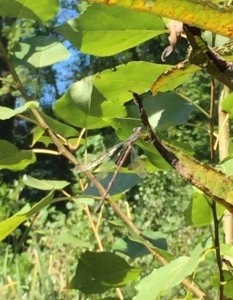
Monthly Archives: September 2015
Late to the Party but Still Paddlin’
I suppose I’m a little slow to the game here but after a much needed 2+ hour phone call with my wonderful mama (broken phone leaves little time or possibility for such extended moments of contact) I have some new thoughts on our meander down the river on Saturday. Much like what a lot of other people, namely Terry, said about the experience being akin to a childhood experience, I found that many of the feelings I recognized physically brought me back to certain moments of my youth. My mom and I spent a good chunk of time today wondering about what children a generation from now will be like and how much different the population’s general activity level is now from how it was in her time or before. We figured in how much time people spend in their cars and offices and homes and how appliances lessen the simple physical tasks of laundry and dishwashing and essentially anything that can be made more efficient with a touch of a button.
She was fortunate enough to grow up in an active family that cherished the outdoors- her father ran a summer camp in his time between teaching high school history, and she and her sisters rode and cared for horses throughout their preteen and teen years. In part because of this, and in part because of my birth occurring riggghhhttt before the technological revolution of the youth, she was able to instill in my sister and me a sense of belonging in nature. She nurtured our interests in snakes and snails and stifled our interests in television. I think it is partly because of this that I so appreciate being able to be alone in the nature that I love.
I think that is part of why I was apprehensive about taking on the Delaware in the company of so many people. To my surprise, I was actually most ruffled up about Ian and Katie being there. It felt like we were all going in on this excursion together and that they weren’t a part of it so somehow their presence would lessen the experience. I was excited to do something I have always loved doing but I was nervous about what it would feel like, with these people, in this setting, in this way. To my pleasant surprise, it was much more freeing than I anticipated. In fact, though I definitely spent the majority of my time pulling forward or to the outsides to be able to kind of do my own thing and see things for myself, some of my favorite parts of the journey were when we were all tethered together and drifting. There was something about that that was at once relaxing and engaging, and it was a new perspective on an encounter with nature for me that I would be interested in repeating.
I know at some point, Joe, Erik and I started to imagine what the camping trip will be like. It was once we had left for the second “half” of the excursion and we were at the front of the group where the water was clear and flat save for the occasional ripples and rocks. The reflection of the trees made it all seem so much fuller, and the frequency of visible housing diminished. With the large hills/small mountains in front of us, it was easy to begin to picture what it might be like out there in the Catskills. I think I will again begin to wonder about the size of the group and the number of the people while we are hiking and such, but I am looking forward to what I now expect to be more pleasant surprises.
Letting Go
On page 179 of “Down the River” Ed Abbey says “Actually our ignorance and carelessness are more deliberate than accidental; we are entering Glen Canyon without having learned much about it beforehand because we wish to see it…not know what to expect, making anew the discoveries of others.” I was very surprised by this passage because it is such opposite thinking to they way that most people tackle Nature in the present. Even for a brief hike or an overnight camping trip, most people come prepared with every single piece of equipment imaginable, everything to cover any situation or misfortune. Part of this preparation is a fear of the unknown and by rolling in with first aid kits and fire starters, we help ease our minds with the thought that we still have some control over what happens to us out in nature. It is a false sense of security that we give ourselves, for if Mother Nature herself has a plan to do us all in, that is her unbreakable will that we cannot maneuver through unless she lets us.
I think to all of the real explorers, the ones who set out without a GPS or extra batteries, who encountered Nature in the realest sense of herself, for those are the people who were their most natural state as well. We must learn to let go of our sense and need to control in order to really experience what is out there.
First Trip Out
Today, Julie, Joe, and myself went out to our site near a bend in Bushkill Creek to spend some time learning about its past, the current state of nature, and man’s interaction with the site. Nestled just underneath the football stadium, the Bushkill lazily meanders around bends that border roads, paths, and lush vegetation. Thousands of flies hovered around slack pools in the Creek, as they also heard the few splashes that we did, indicating that fish were feeding in our vicinity. While the immediate border of the Creek was dense with trees, vines, roots, and other plants, not much else was still left unmolested by man. Standing on the elevated bank of the river, it was hard to communicate with one another; not because of the water’s force, but rather, because of the sound of the road very close behind us. A pump station had a release pipe entering into the Creek, shooting water in a new direction, combating the natural flow of the river.
Beyond the banks, we are sure that an interesting story is to be told from the ruins of old buildings dating back to the 19th century in some instances. Walking around in the shadows of failing brick works, weathered exteriors and windows, we saw numerous signs for different enterprises: paper mills, Cordage companies, and other signs which we will be sure to discover more about. Trees battled foundations, as buildings and nature interacted with one another for space in the compacted area. Auto body garages now take up the space that these former businesses occupied, but they too are also part of the story of our location. It is a unique place because when driving on the road next to our location, it is nearly impossible to know you are next to the Creek; the vegetation is so dense, the flow of the water so removed from the bustle of humankind, it requires getting out and walking practically into the water to discover your natural neighbor.
We look forward to learning more about the aging buildings in our zone, and crafting a story regarding their interaction with the Creek, the College’s interaction with the Creek and buildings (the College owns some land in our site), and understanding why things are in Site 4 the way they are currently. 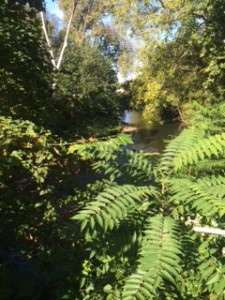
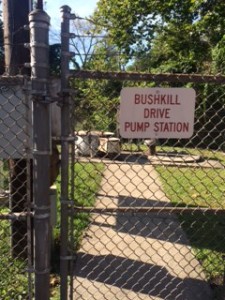
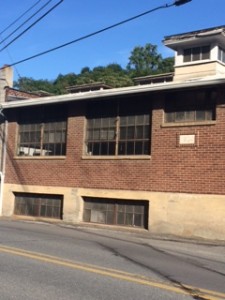
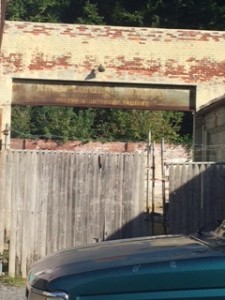
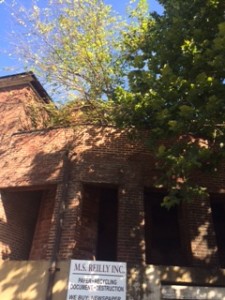
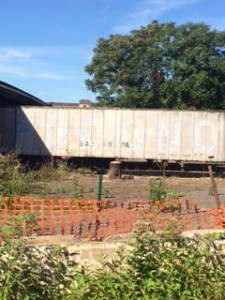
Site 2 Log Report
Team: Nick Gates, Tory Bingaman, Owen McCann
This, our team began our research on Site 2, located along the Bushkill Creek at the bottom of college hill. We noticed the College’s intense redevelopment efforts in the area, noting that the architecture had changed dramatically even since we started at Lafayette.
In previous classes we’ve learned that our site has fallen victim to serious flooding over the years. After some initial research, we learned that the Delaware River (just down the way from our site) flows at 6ft on average. With the Bushkill being a major tributary to the Deleware, flooding clearly poses a serious threat to the Williams Art Campus. We are looking forward to examining how this flooding has effected the businesses, architecture and wildlife on our site.
Places That Used to be Other Places
Saturday on the kayaking trip, Ian, mentioned that after the canals along the river were shut down they were repurposed and turned into a state park. And again, in class today, two instances of abandoned or repurposed places were brought up. They were brought up during the GORP, where we looked at the abandoned cabins in Elkmont, Tennessee and later someone mentioned that the Bushkill Park site for their multimedia project was also an abandoned amusement park
At the mention of the latter, I remembered another abandoned amusement park that once existed near where I grew up. Forest Park was an amusement park that existed in Chalfont, Pennsylvania, around the corner from where I went to elementary school. The park was existed under various different names throughout the 19th century but was finally named Forest Park in 1885. The park drew large crowds of people from Philadelphia and New York, who wished to escape the city for da trips. Some of the main attractions including a swimming pond, swam ride and merry-go-round. The park saw it’s peak numbers in the 1940’s post world-war II but admissions began to decline after a race riot in the late 1950’s and eventually shut down in 1968.
I’ve always had an interest in history, especially appreciated local history and on Saturday, when someone mentioned the importance of such things, I was reminded of these kind of places. Places and features changing over time is inevitable and sort of leads us to think of our own mortality. We remember places so distinctly and to think that in 50 years or 100 years they won’t exist anymore is a daunting thought. So to acknowledge and not forget these historic sites is to really pay respect to every one who ever worked, built or enjoyed these places.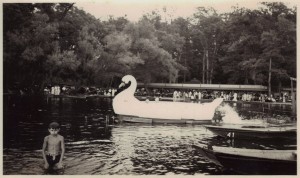
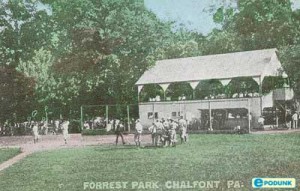
Today, besides what is available online, the only standing homage to Forrest Park is some of the concrete slabs from the site. The Park also inspired the names of some of the neighborhoods that were built around the old site.
Progress Report #1: Site 3 Butz Mill; Ginny, Maggie, & Shawn
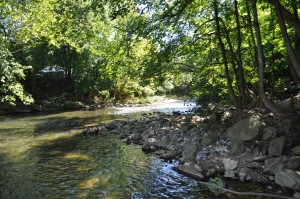
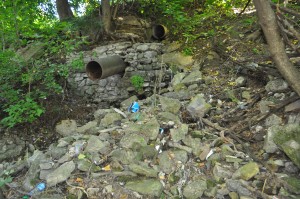
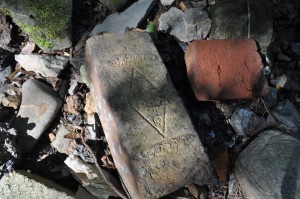 This piece of the Bushkill creek has changed immensely from the pictures of yesteryear. The intense and jarring juxtaposition of natural beauty with disrespectful littering is the most noticeable part of this space. The three of us first walked down to the creek from the arts trail parking lot, right to the left of the public works building. A few workers in the building chatted in the distance as we climbed down towards the water’s edge. We immediately noticed the huge blocks of concrete, broken in places, that were in and around the edge of the creek. They’re certainly leftovers from a building or man-made structure that has been since forgotten. This particular part of our site was not as littered as what we discovered further north. As we were crossing the bridge to begin to walk towards the dam, Ginny pointed out a heron. We deduced that its presence could indicate cleaner water than we may have guessed. As we walked along the sidewalk, with fence on one side and Pearl street on the other, Shawn turned around and held up the picture of a postcard of the site with the brewery on the left and Jefferson mountain on the right. Jefferson mountain now is home to a billboard and scraps which were surely thrown out of car windows. It’s also impossible to see the same scene that the postcard shows since a fence and overgrown trees/shrubs cut the scene directly in half. Once we came close to Safe Harbor, Ginny had to leave for class, so Maggie and Shawn continued around the bend and the building with the address 661 Pearl Street. We followed the edge of the road closely, looking down past the shrubs and trees to try to keep the creek in sight. Directly across from an apartment building called the Bushkill House, we found a small opening in the brush. We started to see litter trailing down a steep, yet still navigable path down to the creek. We climbed/slid down the path, holding on to tree roots on the way down where we found the real meat of this site. Littered with aerosol cans, beer bottles, chip wrappers, gatorade bottles, and all other evidence of human occupation was this fairly large stretch of rocky shore on the west side of the creek. We walked on the rocks up to the dam and back noticing pieces of broken, old-seeming pottery, shells, even more refuse, and yet, a ton of potential. This area is surely a hidden treasure. It wasn’t nearly that difficult to mentally strip the plastic and paper from the scene and picture a clean, natural, beautiful space emerging from under the garbage. We even noticed that above the dam ducks swam, the sun hit the water in a glistening fashion, and not a piece of trash was evident.
This piece of the Bushkill creek has changed immensely from the pictures of yesteryear. The intense and jarring juxtaposition of natural beauty with disrespectful littering is the most noticeable part of this space. The three of us first walked down to the creek from the arts trail parking lot, right to the left of the public works building. A few workers in the building chatted in the distance as we climbed down towards the water’s edge. We immediately noticed the huge blocks of concrete, broken in places, that were in and around the edge of the creek. They’re certainly leftovers from a building or man-made structure that has been since forgotten. This particular part of our site was not as littered as what we discovered further north. As we were crossing the bridge to begin to walk towards the dam, Ginny pointed out a heron. We deduced that its presence could indicate cleaner water than we may have guessed. As we walked along the sidewalk, with fence on one side and Pearl street on the other, Shawn turned around and held up the picture of a postcard of the site with the brewery on the left and Jefferson mountain on the right. Jefferson mountain now is home to a billboard and scraps which were surely thrown out of car windows. It’s also impossible to see the same scene that the postcard shows since a fence and overgrown trees/shrubs cut the scene directly in half. Once we came close to Safe Harbor, Ginny had to leave for class, so Maggie and Shawn continued around the bend and the building with the address 661 Pearl Street. We followed the edge of the road closely, looking down past the shrubs and trees to try to keep the creek in sight. Directly across from an apartment building called the Bushkill House, we found a small opening in the brush. We started to see litter trailing down a steep, yet still navigable path down to the creek. We climbed/slid down the path, holding on to tree roots on the way down where we found the real meat of this site. Littered with aerosol cans, beer bottles, chip wrappers, gatorade bottles, and all other evidence of human occupation was this fairly large stretch of rocky shore on the west side of the creek. We walked on the rocks up to the dam and back noticing pieces of broken, old-seeming pottery, shells, even more refuse, and yet, a ton of potential. This area is surely a hidden treasure. It wasn’t nearly that difficult to mentally strip the plastic and paper from the scene and picture a clean, natural, beautiful space emerging from under the garbage. We even noticed that above the dam ducks swam, the sun hit the water in a glistening fashion, and not a piece of trash was evident.
Another observation noted by our group while exploring the area was the state and modification of one of the buildings represented in old photos still present in the area. We believe this building to be the mill. The building appears to be in fairly good shape as it is still used for the public service workers facility, but while scanning the building we took note of how this structure that once utilized the Bushkill system no longer did and imagined how it might have functioned. There was a strange arch carved into the foundation of this building along the Bushkill and we began to imagine the mill’s water wheel in this abandoned nook. We took note of a pulley at the apex of the roof that must have been used to drag things up to higher floors. We considered the mill pond present in photos, and its absence in this place today. This place provoked our curiosity as we wondered how its interaction with the Bushkill has changed with time.
For further investigation, we would definitely like to get a kayak or if wadeable some waders on this part of the creek to be able to get closer to some of the less accessible parts. We figure that since the shore is right behind Safe Harbor, there’s a good chance this space is used as a hangout for homeless people so we would also like to look into that further and potentially include that in this story. Additionally, we would like to take part in shaping the future of this place by cleaning it up. It is an absolutely beautiful space which would thrive even more if it weren’t covered in garbage.
Dead deer in the Delaware
As we traveled up the final creek of our trip I saw the carcass of a deer underneath the water. When other students started to shout out about the dead deer I thought that I would freak out when I floated over it but a strange calmness and intrigue washed over me. I wanted to know what its story was and how it ended up at the bottom of the creek.
As I floated over the deer I thought of Eiseley and how he touched upon the interconnectedness of us all. I thought about death and how we need to face death like the deer I saw in the creek, we will all die one day. And when that day comes we will eventually become part of the Earth again. The water in our blood will become part of the rivers and our bones will become a part of the soil.
The water floating over the carcass has been floating this Earth for millions of years and the rocks beneath its bones has been there just as long. This Earth is older than all of us and we forget that everything has been there for much longer than we all have. Our own problems are so small compared to the lifetime of the Earth but we get wrapped up in the troubles of our life and forget to look at the big picture. I personally do this and forget to look around and as Walden would say I am asleep.
On this kayaking trip I was able to take a step back from my thoughts and think spiritually like Walden wants us to. I thought about the bigger ideas in life rather than the minuscule issues in my own life. I strangely became okay with the idea of death and accepted it. Seeing the dead deer in the Delaware was a wake up call- death is okay and it is a part of life just as the Earth is a part of our life.
Floating By Trash
I was having an amazing day Saturday kayaking down the Delaware river. It was incredibly peaceful and beautiful. Then I noticed some trash by the side of the river, just a small piece of paper. It broke up the rest of the landscape, stark and white against the brown rocks. It also annoyed me, a lot. I find littering to be one of the things people do that annoys me most because it is so avoidable. Once I had noticed the first piece of litter I began looking for more over and over on the riverbanks. I noticed a lot, probably one piece big or small every 50 or 100 yards.
At one point I noticed a crushed ping pong ball floating 10 feet in front of my cabin. I was in the front of the group, and after trying to catch the ping pong ball and missing, I turned to watch it float away. I watched it float through our entire group, and saw no one pick it up despite all of us caring about the environment. I do not believe this is because we are bad people. I believe it is because most people did not see it, and those who did saw it through the corner of their eye and did not register what it was.
This experience made me think about how much trash we walk by on a daily basis without noticing it. The next morning, thinking about trash I made sure to pay attention to what was on the ground while walking to wawa. In a two block walk I saw two plastic cups, ten cigarette butts, and a panini box. What was incredible to me about this is that I am sure there is the same amount of trash there on a daily basis but I usually never notice any of it. I wonder if other people are like me or I am simply absentminded.
Site 5: Simon Silk Mill – Log Report 1
By Alexa Gatti and Nicole Maksymiw
Today, we explored the Simon Silk Mill site from multiple perspectives. We began in the parking lot at the end of the Karl Stirner Arts Trail and found a run-down pathway leading toward the creek. We sat on an exposed bed of rocks deposited on the edge of the creek. It was clear that this area is submerged in water at times of greater water flow. We wondered how flooding issues may have impacted the location and the mill. Did the force of water cause operational hazards or contribute to the eventual closing of the mill? The rocks around us were damp, so it seems that the force and amount of water in the creek varies regularly and affects the rocks and other features of this area. The rocks in this area were smooth and rounded, mostly of a larger size. This part of the creek was well shaded during the mid-afternoon. The creek appears quite clear and shallow, since the sun shines through the water to the pebbly bottom. Moving at a steady pace, the water movement around the shallow rocks creates many riffles in the creek. The sounds of this area are a mixture of water rushing past these riffles and traffic rushing past in the road.
To our left was a bridge that connected the arts trail side of the road to the silk mill side. Behind us, there was a built stone wall along the arts trail. The brick silk mill was across from us. The windows closed with green-painted wood, looking as if it were still in fairly good condition. on the left side of the mill’s face there is a path of plants sprawling upwards. We wondered how this area may be impacted by invasive species. To the right, the mill looked more decrepit. The glass of the windows were shattered. One large smoke stack stood at the right-hand side of the building. What was emitted from this stack? Water vapor or pollutants? This made us wonder what processes and resources are required to produce silk. Is water a major component of production and, if so, how was the creek impacted by this? We imagined workers coming out to the creek for lunch and commuting to the mill. Who were the workers and what were conditions like in the mill? A little ways down the creek we saw a mysterious structure protruding from the stone wall. We contemplated whether we’d be able to wade to that spot, but opted to hold off. (Nicole was wearing a dress and Alexa had Spanish class in an hour.) We did approach the mysterious contraption from above before returning to the car. We must investigate what it could be but it seems that it would have connected to the mill. Large rusted cables were strung from a thick metal beam. Attached to the cables was a long rusted metal pillar lying horizontally in the water. What purpose did this feature serve? We have not yet investigated the history of the mill so we are eager to piece together a clearer picture of the past.
After wandering in this spot down by the creek, we decided to explore the surrounding area more. We found a “Catch and Release Area” across the road, so there must be a fair amount of recreational fishing just up the creek. A sign on the side of the old silk mill recognized it as Silk: A Creative Community. Silk is an initiative “dedicated to the development and advancement of the creative and cultural industries.” There is also evidence of ongoing construction within the mill. This is a project we will explore further in research.
While walking alongside the mill, we noticed a contrast in design and building materials between the creek side and the far side of the building. The creek side has newer brick patterns, a modern concrete frame of the windows, smoother window boards, and a newer chimney than the circular metal ones on the other section of the building. We look forward to exploring the timeline of development in this location.

